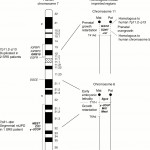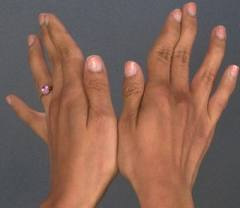Russell-Silver syndrome is a disorder present at birth involving poor growth. One side of the body also will appear to be larger than the other.
Causes, incidence, and risk factors
 Up to 10% of patients with this syndrome have a defect involving chromosome 7. In other patients, there the syndrome may affect chromosome 11, 15, 17, or 18. Researchers suspect that at least one third of all cases of Russell-Silver syndrome result from changes in a process called methylation. Methylation is a chemical reaction that attaches small molecules called methyl groups to certain segments of DNA. In genes that undergo genomic imprinting, methylation is one way that a gene’s parent of origin is marked during the formation of egg and sperm cells. Russell-Silver syndrome has been associated with changes in methylation involving the H19 and IGF2 genes, which are located near one another on chromosome 11. These genes are thought to be involved in directing normal growth. A loss of methylation disrupts the regulation of these genes, which leads to slow growth and the other characteristic features of this disorder.
Up to 10% of patients with this syndrome have a defect involving chromosome 7. In other patients, there the syndrome may affect chromosome 11, 15, 17, or 18. Researchers suspect that at least one third of all cases of Russell-Silver syndrome result from changes in a process called methylation. Methylation is a chemical reaction that attaches small molecules called methyl groups to certain segments of DNA. In genes that undergo genomic imprinting, methylation is one way that a gene’s parent of origin is marked during the formation of egg and sperm cells. Russell-Silver syndrome has been associated with changes in methylation involving the H19 and IGF2 genes, which are located near one another on chromosome 11. These genes are thought to be involved in directing normal growth. A loss of methylation disrupts the regulation of these genes, which leads to slow growth and the other characteristic features of this disorder.
In most patients, the cause is unknown. Most cases occur in people with no family history of the disease.
The estimated number of people who develop this condition varies greatly. Some say it affects about 1 in 3,000 people. Other reports say it affects 1 in 100,000 people. Males and females are equally affected.
Symptoms
- Body asymmetry
- Coffee-with-milk (cafe-au-lait) birth marks
- Curving of the pinky toward the ring finger
- Delayed bone age
- Failure to thrive
- Gastroesophageal reflux disease
- Kidney problems, such as:
- Horseshoe kidney
- Hydronephrosis
- Posterior urethral valves
- Renal tubular acidosis
- Low birth weight
- Large head for body size
- Poor growth
- Short arms
- Short height (stature)
- Short, stubby fingers and toes
- Delayed stomach emptying, and constipation
- Wide forehead with a small triangle-shaped face and small, narrow chin
Signs and tests
The condition is usually diagnosed by early childhood. The doctor will perform a physical exam. Signs include:
- Pointed chin that is not fully developed
- Thin, wide mouth
- Triangle-shaped face with broad forehead
There are no specific laboratory tests to diagnose Russell-Silver syndrome. Diagnosis is usually based on the judgment of your child’s pediatrician. However, the following tests may be done:
- Blood sugar (some children may have low blood glucose)
- Bone age testing (bone age is often younger than the child’s actual age)
- Chromosome testing (may detect a chromosomal problem)
- Growth hormone (some children may have a deficiency)
- Skeletal survey (to rule out other conditions that may mimic Russell-Silver syndrome)
Treatment
Growth hormone replacement may help if this hormone is lacking. The hormones are given by injection typically daily from the age of 2 years old through teenage years. It may be effective even when the patient does not have a Growth Hormone deficiency. Growth Hormone therapy has been shown to increase the rate of growth in patients and consequently prompts ‘catch up’ growth. This may enable the child to begin their education at a normal height, improving their self-esteem and interaction with other children. The effect of growth hormone therapy on mature and final height is as yet uncertain. There are some theories suggesting that the therapy also assists with muscular development and managing hypoglycemia. Other treatments include:
- Making sure the person gets enough calories, to prevent low blood sugar and promote growth
- Physical therapy, to improve muscle tone
- Special education, to address learning disabilities and attention deficit problems the child may have
Many specialists may be involved in treating this condition:
- A doctor specializing in genetics can help diagnose Russell-Silver syndrome.
- A gastroenterologist or nutritionist can help develop the proper diet to enhance growth.
- An endocrinologist may prescribe growth hormone, if it is needed.
- Genetic counselors and psychologists may also be involved.
Expectations (prognosis)
Older children and adults do not show typical features as clearly as infants or younger children. Intelligence may be normal, although the patient may have a learning disability.
Complications
- Chewing or speaking difficulty if jaw is very small
- Learning disabilities
- Treat your child his age not his size. Arrange safe, age-appropriate activities; buy age-appropriate clothes; and expect age-appropriate behavior and responsibility.
- Watch your child’s psychosocial and motor development. All states have developmental evaluation & intervention services for children less than 3. These programs are based on the child’s needs not parental income. For children over 3 years, the school district becomes responsible for providing these services. Take advantage of this; intervention can make a world of difference for your child!
Calling your health care provider
Call your health care child’s provider if signs of Russell-Silver syndrome develop. Make sure your child’s height and weight is measure during each well child visit. The doctor may refer you to:
- A genetic professional for a full evaluation and chromosome studies
- A pediatric endocrinologist for management of your child’s growth problems

